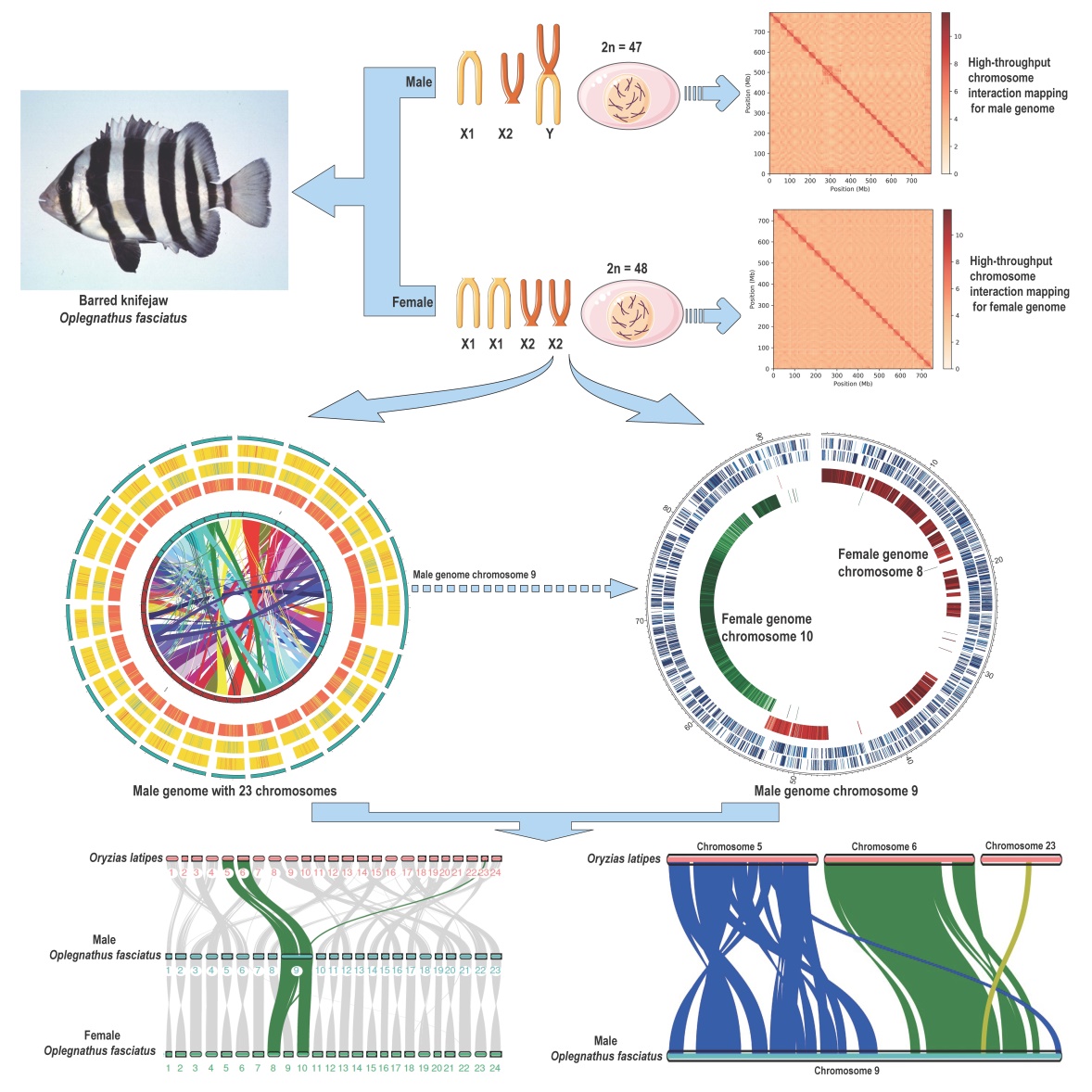搜索结果: 1-15 共查到“海洋生物学 cell”相关记录19条 . 查询时间(0.157 秒)

近日,Cell子刊iScience在线刊发海洋所李军研究组与刘静研究组合作完成的题为“Chromosome-level Genome Reveals the Origin of Neo-Y Chromosome in the Male Barred knifejaw Oplegnathus fasciatus”的研究论文。该研究首次从全基因组层面证实条石鲷雄鱼存在染色体融合现象,解决了雄鱼异型染色...
Identification of senescence and death inEmiliania huxleyiand Thalassiosira pseudonana: Cell staining, chlorophyll alterations, and dimethylsulfoniopropionate (DMSP) metabolism
Identification of senescence death inEmiliania huxleyiand Thalassiosira pseudonana Cell staining chlorophyll alterations dimethylsulfoniopropionate metabolism
2012/4/2
We measured membrane permeability, hydrolytic enzyme, and caspase-like activities using fluorescent cell stains to document changes caused by nutrient exhaustion in the coccolithophore Emiliania huxle...
Relationships between phytoplankton growth and cell size in surface oceans: Interactive effects of temperature, nutrients, and grazing
phytoplankton growth cell size in surface oceans Interactive effects temperature nutrients grazing
2010/4/17
We compile two data sets from14C uptake and dilution experiments conducted in surface waters of the global ocean to investigate the relationship between phytoplankton mass-specific growth rate and cel...
Living at the border: A community and single-cell assessment of lake bacterioneuston activity
Living at the border A community single-cell assessment lake bacterioneuston activity
2010/4/17
We assessed the physicochemical properties of the surface microlayer (SML: first 900mm) and its underlying water (ULW: 0.2–0.5-m depth) and compared the composition and activity of their bacterial com...
Influence of cell cycle phase on calcification in the coccolithophoreEmiliania huxleyi
cell cycle phase calcification coccolithophore Emiliania huxleyi
2008/4/21
Calcification of the cosmopolitan coccolithophore speciesEmiliania huxleyiwas investigated in relation to the cell division cycle with the use of batch cultures. With a 12 : 12 h light : dark cycle, t...
Bacterial release of dissolved organic matter during cell growth and decline: Molecular origin and composition
Bacterial release dissolved organic matter cell growth and decline Molecular origin and composition
2006/5/5
Heterotrophic bacterial growth and the chemical composition of dissolved organic matter (DOM) produced by bacteria from freshwater and marine environments were monitored during experiments with artifi...
Effect of pH on growth, cell volume, and production of freshwater ciliates, and implications for their distribution
pH on growth cell volume production freshwater ciliates
2006/5/4
We investigated the effect of pH on growth, cell volume, and production of the freshwater ciliates Urotricha farcta, U. furcata, and U. castalia in laboratory cultures with Cryptomonas sp. as food. Ov...
Trophic significance of solitary cells of the prymnesiophyte Phaeocystis globosa depends on cell type
Trophic significance solitary cells prymnesiophyte Phaeocystis globosa depends cell type
2006/5/4
With the use of five different isolates of Phaeocystis globosa solitary cells from the North Sea, we conducted experiments to reveal whether grazing and development of the nauplii of the calanoid cope...
The biological and biogeochemical consequences of phosphate scavenging onto phytoplankton cell surfaces
The biological and biogeochemical consequences phosphate scavenging phytoplankton cell surfaces
2005/9/13
Phytoplankton carbon (C) and nitrogen (N) content is commonly normalized to phosphorus (P) quotas as Redfield C:N: P ratios. We examined how surface-bound P pools affect Redfield stoichiometry and P u...
Diel variations in the photosynthetic parameters of Prochlorococcus strain PCC 9511: Combined effects of light and cell cycle
Diel variations photosynthetic parameters Prochlorococcus strain PCC 9511 light and cell cycle
2005/5/9
We examined the mechanisms related to the diel variations in the parameters of the relationship between the rate of carbon fixation of phytoplankton and irradiance (P vs. E curve). Our goal was to und...
Bioluminescent response of the dinoflagellate Lingulodinium polyedrum to developing flow: Tuning of sensitivity and the role of desensitization in controlling a defensive behavior of a planktonic cell
Bioluminescent response dinoflagellate Lingulodinium polyedrum developing flow Tuning of sensitivity desensitization controlling a defensive behavior planktonic cell
2005/5/9
Dinoflagellate bioluminescence is believed to serve a defensive function, decreasing grazing at night. Previous characterization of bioluminescence stimulated by fully developed flows might have under...
The demise of the marine cyanobacterium, Trichodesmium spp., via an autocatalyzed cell death pathway
marine cyanobacterium Trichodesmium spp. uncatalyzed cell death pathway
2004/5/19
We present experimental laboratory evidence and field observations of an autocatalyzed, programmed cell death (PCD) pathway in the nitrogen-fixing cyanobacterium Trichodesmium spp., which forms massiv...
Effect of iron deficiency on diatom cell size and silicic acid uptake kinetics
iron deficiency diatom cell size silicic acid uptake kinetics
2004/5/19
We studied the silicic acid uptake kinetics of the pennate diatom Cylindrotheca fusiformis grown under a wide range of iron concentrations (from Fe-limiting to Fe-sufficient conditions) to assess the ...
Relating cell-level swimming behaviors to vertical population distributions in Heterosigma akashiwo (Raphidophyceae), a harmful alga
cell-level swimming vertical population distributions Heterosigma akashiwo a harmful algal
2004/5/14
Cell motility may facilitate the formation of harmful algal blooms (HABs) by enabling algal cells to swim to favorable microenvironments that support explosive growth. Motility also augments the forma...
Population growth and transport of the red tide dinoflagellate, Noctiluca scintillans, in the coastal waters off Sydney Australia, using cell diameter as a tracer
Population growth transport of the red tide dinoflagellate Noctiluca scintillans, in the coastal waters off Sydney Australia using cell diameter as a tracer
2003/3/20
Spatial abundance patterns of the heterotrophic dinoflagellate, Noctiluca scintillans, were investigated along the southeast coast of Australia to address the hypothesis that population growth of Noct...

